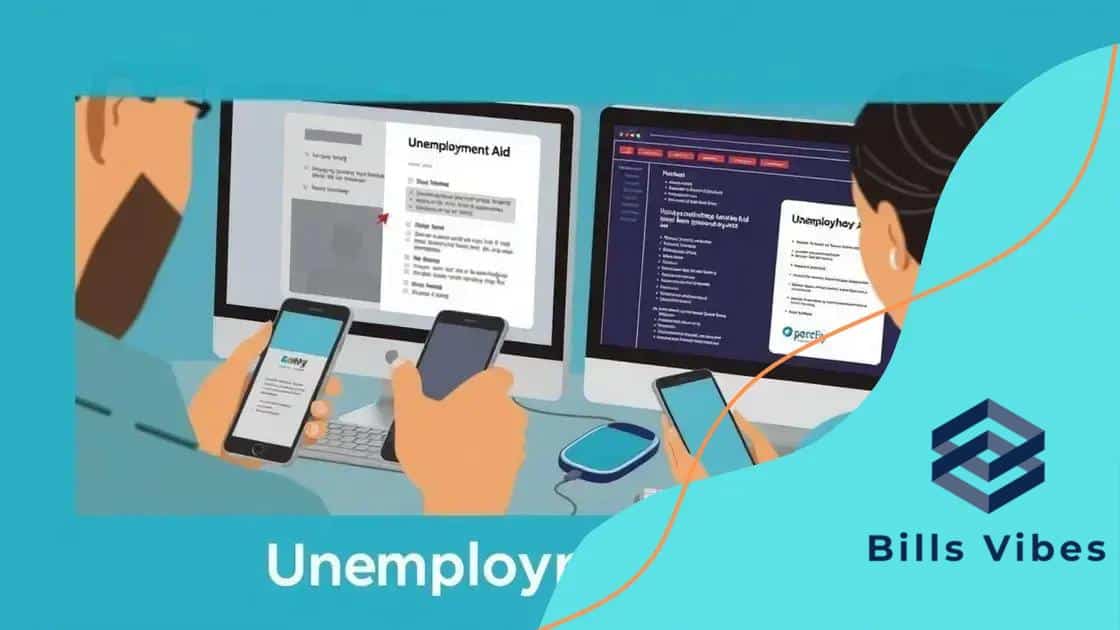Unemployment aid modernization: a fresh look at reforms

Unemployment aid modernization involves improving access and efficiency through technology, addressing funding challenges, and adapting to new workforce dynamics for better support systems.
Unemployment aid modernization is a pressing issue, as many are seeking effective support during tough times. Have you ever wondered how these changes affect the way assistance is delivered? Let’s dive into what’s happening in this crucial area.
Understanding the current unemployment aid system
We need to grasp how the unemployment aid system works today. Understanding the current unemployment aid system is essential for anyone seeking support when facing job loss. Many people depend on these programs, so it’s vital to know what’s available.
A Brief Overview of the System
The unemployment aid system usually provides temporary financial assistance to individuals who are out of work. To qualify, applicants often must have a certain work history and meet other requirements. Benefits vary by state, as each state administers its own program.
Key Components of Unemployment Aid
- Eligibility criteria: Applicants must show they lost their job through no fault of their own.
- Benefit amount: Payments typically replace a portion of lost wages, often capped at a certain limit.
- Duration of benefits: Benefits can last several weeks to months, depending on unemployment rates and state laws.
- Job search requirements: Many states require recipients to actively seek employment while receiving aid.
Understanding these components helps applicants know what to expect when they apply for assistance. However, navigating the system can be challenging, especially with varying rules in each state. It’s crucial to stay informed about potential changes that could impact eligibility and benefit amounts.
The unemployment aid system is not only a safety net but also a critical support system during economic downturns. With the right information, individuals can access the help they need to get back on their feet.
Key reforms in unemployment assistance
Several key reforms in unemployment assistance have emerged to adapt to the changing economic landscape. These reforms aim to make support systems more efficient, accessible, and responsive to the needs of individuals facing job loss.
Improved Benefit Processing
Reforms have streamlined the application process, allowing for quicker access to benefits. Many states have implemented online systems that simplify application submissions. This shift reduces processing times and removes barriers for those in need of immediate support.
Increased Flexibility for Recipients
Another significant reform involves increasing the flexibility of benefits. Many programs now allow for a combination of part-time work and unemployment assistance, enabling individuals to transition back into the workforce while still receiving support. This dual approach helps to cushion financial impacts during the job search.
- Partial unemployment benefits: Recipients can earn a limited income without losing their benefits entirely.
- Expanded eligibility: Some states broadened criteria to include gig workers and self-employed individuals.
- Skills training programs: Many states now offer training and education to help individuals gain new skills, making them more competitive in the job market.
The integration of technology into the unemployment assistance system is also a hallmark of recent reforms. By utilizing data and analytics, states can better identify individuals who might need additional help and can tailor programs to meet specific needs.
These reforms reflect a growing recognition that enhancing the unemployment assistance system is critical in promoting economic recovery and ensuring individuals receive the help they need to regain employment.
The role of technology in aid delivery

The role of technology in aid delivery is increasingly vital in the modern unemployment assistance system. Advances in technology streamline processes, making it easier for individuals to access support when they need it.
Digital Application Platforms
Many states now offer digital platforms where applicants can easily submit their applications. This shift helps reduce paperwork and speeds up the process. Online systems allow for immediate updates and clear communication regarding the status of claims. This technology ensures that individuals can track their benefits without the hassle of phone calls or in-person visits.
Data Analysis for Improved Services
Data analysis plays a crucial role in identifying trends and needs within unemployment services. By analyzing patterns, states can better allocate resources and target assistance to those most in need.
- Personalized recommendations: Technology can provide tailored job matching services to individuals based on their skills and experiences.
- Real-time support: Chatbots and online help centers offer immediate assistance, making the navigation of aid processes much smoother.
- Remote training programs: Individuals can access job training online, making it easier to acquire new skills needed for employment.
Furthermore, the use of mobile applications enhances engagement with beneficiaries, enabling them to receive updates and resources directly on their phones. This approach caters to a wider audience, especially those who may find traditional methods of communication challenging.
Overall, the integration of technology in the delivery of unemployment aid is transforming how support is accessed, making it more efficient and user-friendly. With continuous innovations, aid systems are evolving to better meet the needs of a changing workforce.
Challenges in modernization efforts
Many challenges in modernization efforts arise as systems work to improve unemployment assistance. These challenges can hinder effective implementation and impact those who rely on these services.
Funding and Resources
One significant challenge is securing adequate funding for modernization initiatives. Many programs struggle with limited budgets, which restricts their ability to adopt new technologies or improve existing programs. Ensuring sufficient resources are available is crucial for effective updates.
Staff Training and Adaptation
Another hurdle lies in training staff to use new systems and technologies effectively. Employees accustomed to traditional methods may find it challenging to switch to digital platforms or new processes. Ongoing training and support are necessary to ensure a smooth transition.
- Resistance to change: Some staff members may resist changes, preferring established methods.
- Technical difficulties: New systems can encounter technical issues that disrupt service delivery.
- Communication gaps: Miscommunication between teams can lead to misunderstandings and delays.
Furthermore, addressing the needs of diverse populations presents a challenge. Programs must cater to individuals with varying levels of tech literacy and access to resources. Ensuring that everyone can benefit from modernization efforts is vital.
Finally, tracking the effectiveness of these modernization efforts remains a constant challenge. Programs require robust metrics to evaluate success and make adjustments. Continuous feedback can help identify areas for improvement, allowing for better adaptation in future initiatives.
Future outlook for unemployment support
The future outlook for unemployment support is shaped by evolving economic conditions and shifts in workforce dynamics. As the job market changes, so do the needs of individuals seeking assistance.
Adapting to Remote Work
With an increase in remote work opportunities, unemployment support systems will likely evolve to include resources tailored for this new format. Future programs may focus on providing access to technology and training for remote job opportunities, ensuring that individuals have the skills needed in a digital workspace.
Incorporating Universal Basic Income (UBI)
Some experts suggest that exploring concepts like Universal Basic Income (UBI) could reshape unemployment support. UBI aims to provide a regular, unconditional payment to individuals, ensuring a baseline income regardless of employment status. This change could foster economic stability and provide a safety net during tough times.
- Increased flexibility: Programs may offer more flexible support that adapts to individual circumstances.
- Focus on skills training: As automation rises, unemployment support may emphasize reskilling and upskilling programs.
- Expanded eligibility: Future systems might broaden eligibility criteria to include gig and freelance workers.
Moreover, the integration of technology will play a crucial role in shaping future unemployment support. Data analytics can help identify trends and better allocate resources to meet changing needs. Enhanced digital platforms will facilitate easier access to benefits and resources.
As policymakers and organizations explore new solutions, the focus remains on creating a sustainable and effective support system that meets the challenges of the modern workforce.
FAQ – Frequently Asked Questions about Unemployment Aid Modernization
What are the main goals of modernizing unemployment aid?
The main goals include improving access to support, utilizing technology for faster processing, and making the system more responsive to people’s needs.
How has technology changed unemployment assistance?
Technology has streamlined application processes, allowed for online access, and provided real-time data to enhance service delivery.
What challenges do modernization efforts face?
Challenges include securing funding, training staff on new systems, and ensuring that all populations can access the updated services.
What is the future outlook for unemployment support?
The future looks to integrate more technology, possibly explore concepts like Universal Basic Income, and adapt to the evolving workforce requirements.






